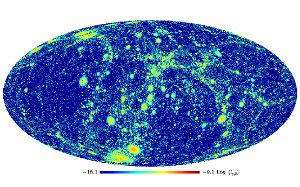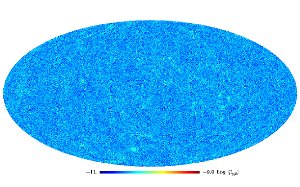|
|  |
Although dark matter accounts for most of the matter in the Universe,
its nature remains unknown. So far the presence of dark matter has
only been inferred through its gravitational effects. However, if dark
matter is made of neutralinos, a new particle predicted by
Supersymmetry, it would also interact, although very weakly, with
ordinary matter, and it might be detected soon in laboratories on
Earth. In addition, neutralinos, being Majorana fermions, can
self-annihilate to produce ordinary particles like positrons,
neutrinos and gamma-ray photons. If these byproducts of the
annihilation are copious enough, they could be detected by satellites
such as FERMI, which has been mapping the gamma-ray sky since mid
2008.
This gamma-ray radiation is produced most abundantly in high density
regions. Thus, it seems best to look for it in very dense nearby
regions, such as the centre of our own Galaxy and/or the centres of
its satellite galaxies. Actually, it turns out that the best prospects
for the detection of gamma-rays from our Galaxy are obtained by
looking slightly off-centre to avoid confusion of the signal with
other sources of gamma rays residing at the Galactic centre
( see Research Highlight December 2003). see Research Highlight December 2003).
However, outside of the Galactic halo, gamma-rays are also produced in
large quantities by the annihilation of dark matter in all the many
haloes and subhaloes within our past light-cone, contributing to
the so-called extragalactic gamma-ray background (EGB)
radiation. Although the EGB also receives contributions from other
sources, such as blazars and cosmic rays accelerated at structure
formation shocks, the energy spectrum and angular power spectrum of
the annihilation radiation have distinctive features that may open up
effective ways for disentangling the signal. Therefore, a detailed
analysis of the EGB is a viable possibility for detecting dark matter.
In a new study, scientists at the MPA used the state-of-the-art
Millennium-II simulation (an MPA project) to generate all-sky maps of the contribution
of dark matter annihilation to the EGB radiation. A special map-making
procedure was developed that re-creates the past light cone of a
fiducial galactic observer, taking into account the gamma-ray
luminosity of all numerically resolved haloes and their subhaloes. The
method also includes corrections for unresolved components of the
emission as well as an extrapolation to the minimum mass for bound
neutralino dark matter haloes. The angular resolution of the created
maps was chosen to be close to that of FERMI, approximately 0.115 degrees.
It was found that for most of the relevant energy range (0.1-30 GeV),
the signal comes mainly from sources up to redshifts z~2. In the
most optimistic scenario considered, the energy spectrum of the
isotropic component of the background radiation lies approximately one
order of magnitude below the values of the EGB measured by the telescope EGRET
(predecessor of FERMI) in the energy range 1-20
GeV, where an apparent excess of gamma-rays had led to speculations of
a possible origin in dark matter annihilations. The results found by the MPA-team indicate
that if this excess is indeed confirmed by FERMI, then annihilation of
neutralinos could only account for the signal if the annihilation
process is somehow enhanced. Several mechanisms have been proposed
that may indeed yield such an enhancement, such as the presence of
highly dense “spikes” of dark matter formed around intermediate-mass
black holes (with masses between a hundred and a million solar masses), or
the so-called Sommerfeld enhancement, a quantum-mechanical focusing
effect that increases the annihilation cross section.
The MPA-team also studied the anisotropic component of the EGB by
computing the angular power spectrum of the simulated maps. This
yielded specific predictions for the shape of the power spectrum,
which can potentially be used to discriminate against other sources of
gamma-rays because the annihilation signal depends in a specific and
unique way on the large-scale distribution of haloes, on the
distribution of subhaloes within haloes, and on the abundance and
internal structure of haloes as a function of time. Also, the shape of
the power spectrum was found to depend on the energy of the
observations. Interestingly, these differences can be exploited to
construct “color” maps that enhance the signal of nearby dark matter
structures, akin to hardness ratio maps in X-ray observations. For
example, the MPA scientists found that taking the ratio of the maps at energies of
0.1 GeV and 32 GeV greatly enhances the contrast of local dark
matter structures, making them clearly visible in the gamma-ray
sky. If strong spectral features in the rest-frame emission spectrum
of the annihilation radiation are present, this could be especially
powerful, perhaps even allowing tomographic observations of dark
matter structures.
Jesus Zavala, Volker Springel and Michael Boylan-Kolchin
Publications
Jesus Zavala, Volker Springel, Michael Boylan-Kolchin,
"Extragalactic gamma-ray background radiation from dark matter annihilation",
2009, submitted to MNRAS.
 arXiv:0908.2428v2 arXiv:0908.2428v2
|







